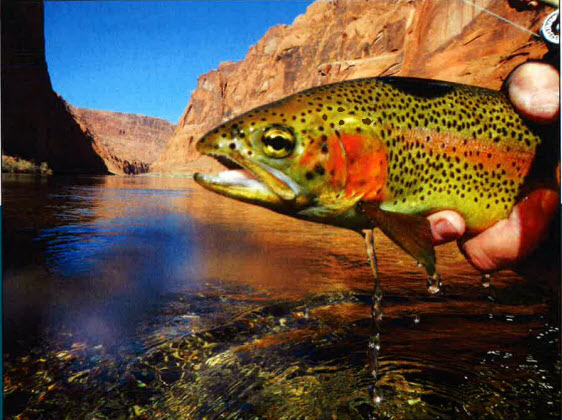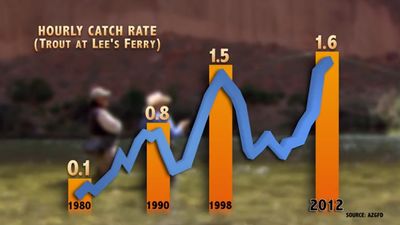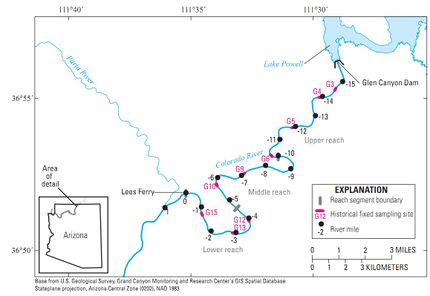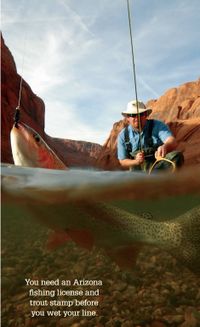Difference between revisions of "FISHERY"
Cellsworth (Talk | contribs) |
Cellsworth (Talk | contribs) |
||
| Line 15: | Line 15: | ||
</td> | </td> | ||
</tr> | </tr> | ||
| + | [[File:GlenCanyonTrout.jpg]] | ||
</table> | </table> | ||
| − | |||
<!-- | <!-- | ||
| Line 24: | Line 24: | ||
In 1964, the Lees Ferry tailrace on the Colorado River was given birth by the completion of Glen Canyon Dam, which impounded Lake Powell. Subsequent water releases from the bottom of Lake Powell changed the once highly turbid, warm waters of the Colorado River into a constant cold (46-50°F), clear flowing river. Shortly after completion of the dam, the Arizona Game and Fish Department stocked rainbow trout (Oncorhynchus mykiss) in the 15-mile Lees Ferry reach and, in 1981, began to manage this section of river as a Blue Ribbon trout fishery. The trout began to flourish in the Lees Ferry reach from 1970-1985 when catches of rainbow trout above 10-pounds were not uncommon, and angler pressure was relatively low. In 1991, however, the Bureau of Reclamation implemented the Record of Decision flow regime, which consisted of higher minimum and more stable flows and allowed for increased trout reproduction and survival. Under these conditions, a huge population of trout developed causing individual fish growth rates to decline. Quite simply, there was a large number of fish competing for limited space and food items, resulting in a fishery where trout less than 14-in were dominant. | In 1964, the Lees Ferry tailrace on the Colorado River was given birth by the completion of Glen Canyon Dam, which impounded Lake Powell. Subsequent water releases from the bottom of Lake Powell changed the once highly turbid, warm waters of the Colorado River into a constant cold (46-50°F), clear flowing river. Shortly after completion of the dam, the Arizona Game and Fish Department stocked rainbow trout (Oncorhynchus mykiss) in the 15-mile Lees Ferry reach and, in 1981, began to manage this section of river as a Blue Ribbon trout fishery. The trout began to flourish in the Lees Ferry reach from 1970-1985 when catches of rainbow trout above 10-pounds were not uncommon, and angler pressure was relatively low. In 1991, however, the Bureau of Reclamation implemented the Record of Decision flow regime, which consisted of higher minimum and more stable flows and allowed for increased trout reproduction and survival. Under these conditions, a huge population of trout developed causing individual fish growth rates to decline. Quite simply, there was a large number of fish competing for limited space and food items, resulting in a fishery where trout less than 14-in were dominant. | ||
| − | In 2000, the Arizona Game and Fish Department began a long-term monitoring program sponsored by | + | In 2000, the [http://www.azgfd.gov/w_c/research_managing_lees_ferry.shtml| Arizona Game and Fish Department] began a long-term monitoring program sponsored by [http://www.gcmrc.gov/| Grand Canyon Monitoring and Research Center] to determine the effects of Glen Canyon Dam operation on the trout fishery at Lees Ferry and to make recommendations for improving this fishery. Since 2000, our data collection has shown an increase in the general health of all trout age classes (especially since 2002). This increase in fish health is usually associated with an increase in growth rates. There has been a marked increase in catch rates of young-of-the-year fish in recent years. With successful spawning and recruitment continuing to occur, fishing conditions in Lees Ferry are improving. |
| − | + | ||
| − | + | ||
| − | + | ||
| − | + | ||
| Line 81: | Line 77: | ||
UP-RIVER SUMMARY | UP-RIVER SUMMARY | ||
| − | |||
| − | We have not been blessed with good weather; | + | The spring fishing season at Lees Ferry has thus far been very interesting. We have not been blessed with good weather; it has been many years since we have seen strong winds like the ones we have experienced, with many days too windy and dangerous to launch our boats. |
| − | it has been many years since we have seen strong winds like the ones we have experienced, with many days too windy and dangerous to launch our boats. | + | |
Good news is that the river saw an epic spawn this year. Up until the middle of April, just about every fish in the river was spawning and all was in the deeper water. This is good and bad … it made for tough fishing conditions: when fish spawn in the deep water it is tough to get a fly down to them and there were few fish in the shallows to fish to. | Good news is that the river saw an epic spawn this year. Up until the middle of April, just about every fish in the river was spawning and all was in the deeper water. This is good and bad … it made for tough fishing conditions: when fish spawn in the deep water it is tough to get a fly down to them and there were few fish in the shallows to fish to. | ||
| Line 108: | Line 102: | ||
SPIN FISHING SUMMARY. | SPIN FISHING SUMMARY. | ||
Spin fishing continues to be OK but the large amount of algae in the river is making it difficult to keep the lure clean and a trout will rarely eat a lure or fly that has algae attached. | Spin fishing continues to be OK but the large amount of algae in the river is making it difficult to keep the lure clean and a trout will rarely eat a lure or fly that has algae attached. | ||
| − | |||
| − | |||
| − | |||
| − | |||
| Line 165: | Line 155: | ||
|- | |- | ||
|style="color:#000;"| | |style="color:#000;"| | ||
| + | |||
| + | |||
2016 | 2016 | ||
| + | *[[2015 News about the declining fish status at Fishery|Update on the 2015 decline in fish condition and abundance at Lees Ferry]] | ||
*[http://www.usbr.gov/uc/rm/amp/twg/mtgs/16jan26/documents/Attach_05.pdf '''Brown Trout Update Lees Ferry'''] | *[http://www.usbr.gov/uc/rm/amp/twg/mtgs/16jan26/documents/Attach_05.pdf '''Brown Trout Update Lees Ferry'''] | ||
*[http://www.usbr.gov/uc/rm/amp/twg/mtgs/16jan26/documents/Attach_06.pdf '''Trout Ad Hoc Group Report'''] | *[http://www.usbr.gov/uc/rm/amp/twg/mtgs/16jan26/documents/Attach_06.pdf '''Trout Ad Hoc Group Report'''] | ||
*[http://www.usbr.gov/uc/rm/amp/twg/mtgs/16jan26/documents/Attach_07b.pdf '''Lees Ferry Recreational Trout Fishery Management Recommendations: The Voice of Lees Ferry Recreational Anglers, Guides, and Businesses'''] | *[http://www.usbr.gov/uc/rm/amp/twg/mtgs/16jan26/documents/Attach_07b.pdf '''Lees Ferry Recreational Trout Fishery Management Recommendations: The Voice of Lees Ferry Recreational Anglers, Guides, and Businesses'''] | ||
*[http://www.usbr.gov/uc/rm/amp/twg/mtgs/16jan26/documents/Attach_07c.pdf '''Memo from Scott VanderKooi to TWG Chair Dated 12/9/15, Subject: Technical Review of the Lees Ferry Recreational Trout Fishery Management recommendations'''] | *[http://www.usbr.gov/uc/rm/amp/twg/mtgs/16jan26/documents/Attach_07c.pdf '''Memo from Scott VanderKooi to TWG Chair Dated 12/9/15, Subject: Technical Review of the Lees Ferry Recreational Trout Fishery Management recommendations'''] | ||
| − | |||
*[ '''Natal Origins of Rainbow Trout Project, Years 1-4 (Nov 11 – Dec 15) '''] | *[ '''Natal Origins of Rainbow Trout Project, Years 1-4 (Nov 11 – Dec 15) '''] | ||
*[ '''Bioenergetic Modeling of Glen Canyon Rainbow Trout Fishery: Exploring effects of temperature, trout population size and biomass on benthic invertebrate consumption '''] | *[ '''Bioenergetic Modeling of Glen Canyon Rainbow Trout Fishery: Exploring effects of temperature, trout population size and biomass on benthic invertebrate consumption '''] | ||
| Line 182: | Line 174: | ||
*[http://www.usbr.gov/uc/rm/amp/twg/mtgs/15oct20/pdfs/Attach_06a.pdf '''GCMRC review of the Lees Ferry Anglers Trout Fishery Recommendations'''] | *[http://www.usbr.gov/uc/rm/amp/twg/mtgs/15oct20/pdfs/Attach_06a.pdf '''GCMRC review of the Lees Ferry Anglers Trout Fishery Recommendations'''] | ||
*[http://www.usbr.gov/uc/rm/amp/twg/mtgs/15oct20/pdfs/Attach_06b.pdf '''Management Prescription'''] | *[http://www.usbr.gov/uc/rm/amp/twg/mtgs/15oct20/pdfs/Attach_06b.pdf '''Management Prescription'''] | ||
| − | + | *[https://drive.google.com/file/d/0BwY-Z2c3NTUGUnMyazlBQUVSaXc/view '''Mercury levels in Glen Canyon trout'''] | |
*[http://www.usbr.gov/uc/rm/amp/twg/mtgs/15apr21/Attach_12.pdf '''Potential Application of an Individual-Based Model to the Glen Canyon'''] | *[http://www.usbr.gov/uc/rm/amp/twg/mtgs/15apr21/Attach_12.pdf '''Potential Application of an Individual-Based Model to the Glen Canyon'''] | ||
*[http://www.usbr.gov/uc/rm/amp/twg/mtgs/15apr21/Attach_11.pdf '''Glen Canyon Tailwater Fishery “Integrating Fish and Channel Mapping'''] | *[http://www.usbr.gov/uc/rm/amp/twg/mtgs/15apr21/Attach_11.pdf '''Glen Canyon Tailwater Fishery “Integrating Fish and Channel Mapping'''] | ||
| Line 212: | Line 204: | ||
[[Image:Vermillion Video- Fishing.jpg|thumb|300px]]<br>'''[http://vimeo.com/76818138 Vermillion: Highlights the passion the fishing community has for the Glen Canyon fishery and their love of not only the fishing experience but for the TOTAL experience. VIDEO LINK]''' | [[Image:Vermillion Video- Fishing.jpg|thumb|300px]]<br>'''[http://vimeo.com/76818138 Vermillion: Highlights the passion the fishing community has for the Glen Canyon fishery and their love of not only the fishing experience but for the TOTAL experience. VIDEO LINK]''' | ||
| + | |||
| + | |||
| + | |||
| + | |||
| + | |||
| + | |||
| + | |||
Revision as of 16:09, 31 May 2016
|
|
In 1964, the Lees Ferry tailrace on the Colorado River was given birth by the completion of Glen Canyon Dam, which impounded Lake Powell. Subsequent water releases from the bottom of Lake Powell changed the once highly turbid, warm waters of the Colorado River into a constant cold (46-50°F), clear flowing river. Shortly after completion of the dam, the Arizona Game and Fish Department stocked rainbow trout (Oncorhynchus mykiss) in the 15-mile Lees Ferry reach and, in 1981, began to manage this section of river as a Blue Ribbon trout fishery. The trout began to flourish in the Lees Ferry reach from 1970-1985 when catches of rainbow trout above 10-pounds were not uncommon, and angler pressure was relatively low. In 1991, however, the Bureau of Reclamation implemented the Record of Decision flow regime, which consisted of higher minimum and more stable flows and allowed for increased trout reproduction and survival. Under these conditions, a huge population of trout developed causing individual fish growth rates to decline. Quite simply, there was a large number of fish competing for limited space and food items, resulting in a fishery where trout less than 14-in were dominant. In 2000, the Arizona Game and Fish Department began a long-term monitoring program sponsored by Grand Canyon Monitoring and Research Center to determine the effects of Glen Canyon Dam operation on the trout fishery at Lees Ferry and to make recommendations for improving this fishery. Since 2000, our data collection has shown an increase in the general health of all trout age classes (especially since 2002). This increase in fish health is usually associated with an increase in growth rates. There has been a marked increase in catch rates of young-of-the-year fish in recent years. With successful spawning and recruitment continuing to occur, fishing conditions in Lees Ferry are improving.
|
| --- |
--- | --- |
|---|
HISTORY
POTENTIAL THREATS: |
ADDITIONAL LINKS |




